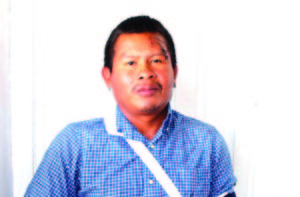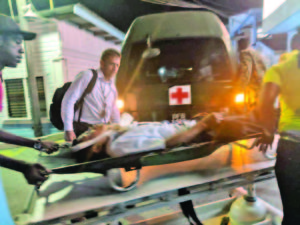Days after a Cessna 182 aircraft with registration number N8704T crashed at Canal Number Two Polder, West Bank Demerara, the pilot, Lincoln Gomez, who is recuperating from his injuries stated that he declared an emergency as the aircraft descended to 2000 feet.
As the plane continued to descend, he noted that it was a full moon and the clouds covered the sky thus making visibility difficult.
In a post on social media, the pilot recalled the horrific accident that occurred on the evening of February 18. He explained that on the day in question, plans were already made for him to fly to Paramakatoi from Ogle to take building materials for Monkey Mountain.

He noted that as he was on his way to the Ogle Airport from Georgetown in a taxi, a member of the church received a telephone call from one of his colleagues instructing him to fly to Arau instead. At that time, he was told that he had to pick up a patient who was involved in an accident.
“I made up my mind to fuel the aeroplane and fly to Arau instead of Paramakatoi. A few minutes later, we received the sad news that our fellow missionary from the US who was involved in the accident, died. I just could not believe the news. It was so shocking,” he added.
He, however, decided to continue his journey to Paramakatoi after fuelling and loading the plane.
“I landed there (Paramakaroi) after noon and spent some time there. Eighteen minutes after taking off from there I received news from the control tower that I should fly to Kaikan, pick up a policeman, and continue to Arau to pick up the corpse and fly it to Georgetown. So I diverted my flight and soared to 8500 to Mean Sea Level (MSL) to fly to Kaikan”.
On his way to Kaikan, he again received instructions to make another diversion to pick up someone to take to Kaikan.
After following orders, he flew to Arau and about a minute after he landed, the corpse arrived at the airstrip.
“I was told that Police would arrive “just now”. I waited for more than an hour, I guess, for the policemen to arrive. Finally, they arrived and one of them was to fly with me as an escort to accompany the corpse” Gomez stated.

At that time, the pilot recalled, he told them it was late and that he would fly to Paruima and spend the night there but as he entered that aircraft, the corpse had already created a stench so he decided to fly to Georgetown. He thought that more delays would result in the corpse decaying.
“I had already measured the fuel in the plane and had enough to fly to town according to the fuel burn measuring instrument and calculations.”
They took off for Ogle but after some time, he requested from the control tower if he could fly Instrument Flight Rules (IFR) and after getting the confirmation, he agreed, not knowing the implications.
In clarifying the Instrument Flight Rules (IFR), a source explained that after visibility becomes impossible, the pilot can request to switch to IFR where the plane is now navigated by instruments.
Nevertheless, Gomez stated “at some point, I was asked to descend to 2000 from 7000ft MSL. So I descended. I looked at the fuel indicator from time to time as usual and it was getting lower but I trusted that I had enough knowing how much the indicator usually indicates fuel burn”.
He noted that they had already crossed the Essequibo River when the engine began to idle. He recalled that the place was dark and he attempted to troubleshoot an engine failure.
He attempted to troubleshoot an engine failure but nothing worked hence, he immediately declared an emergency. During this time, he recalled the policeman who was later identified as Mark Grimmond panicked.
“I did not want to be distracted by him. As I was busy reporting our position… the aeroplane touched the trees and I lost consciousness”.
When he regained consciousness, he was outside of the plane. He was pulled from the wreckage by the policeman who also made sure that other items from the aircraft were taken out along with the corpse from Arau.
“All I could have done was to maintain glide speed until touchdown,” the pilot added while noting that Grimmond was able to make calls using his mobile phone and handle the flares.
After some time, he related, an aeroplane and a helicopter flew over the location. “They were able to spot us with the help of flares and other means.
About four hours after we went down, the soldiers rescued us by land and we were able to walk slowly through the jungle for about an hour to the helicopter. Afterwards, we were flown to Army base and then driven to the hospital”, he recalled.



